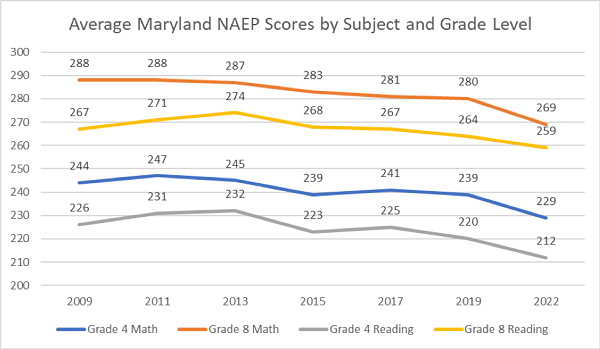BALTIMORE, MD—Maryland State Department of Education officials say state student scores followed a national declining trend on the 2022 National Assessment of Educational Progress (NAEP), continuing a downward trajectory that began in 2013 and worsened during the pandemic.
Maryland participates in the NAEP, a biennial assessment of fourth and eighth graders in reading and math. The assessment measures achievement at four levels: below basic, basic, proficient, and advanced. The NAEP assessment measures four levels of achievement on NAEP based on cut scores set for basic, proficient, and advanced. The fourth level, below basic, is by default and denotes performance that falls below the lowest achievement level. Testing results indicate that a majority of Maryland fourth and eighth grade students were not proficient in mathematics or reading. The largest decline in proficiency in Maryland and nationally was experienced in mathematics; 75 percent of Maryland eighth grade students and 69 percent of fourth grade students are at or below basic achievement in mathematics.
“The fourth and eighth grade 2022 NAEP reading and math assessment results confirm that the learning of all students suffered during the pandemic and also underscore the unacceptable opportunity and achievement gaps that continue to persist for Maryland’s Black, Hispanic, and economically disadvantaged students,” said State Superintendent of Schools Mohammed Choudhury. “As we continue to implement the Blueprint for Maryland’s Future and transform education, we must be innovative, collaborative and bold in our approaches to enhance and accelerate student achievement. There is no sugar coating these results. Maryland has been experiencing a downward trend since 2013, and a return to normal is not good enough. The current struggles of our students cannot be solely attributed to the pandemic. Our goal is to ensure that every Maryland student has access to excellent educational opportunities to realize their full potential, especially those who have been historically underserved.”
“The work that is currently underway will provide the foundation to implement best in class and evidence-based strategies across every classroom to ensure that Maryland students are performing competitively across the nation, achieving at the highest levels and prepared to thrive in college, careers and life,” continued Superintendent Choudhury.
The decline in Maryland’s 2022 NAEP scores in all four grade – subject areas tested is consistent with the testing results of most States. Specifically, average scores for Maryland students eligible for the National School Lunch Program declined for both fourth and eighth grade students in reading and math compared to 2019 results. The scores of Black and Hispanic students also declined significantly from 2019 in three of the four grade – subject categories. Black students experienced decreases in eighth grade reading and math, as well as fourth grade math. Hispanic students experienced decreases in fourth grade reading and math, and eighth grade math. Students with disabilities remained relatively unchanged from 2019 in all grades and subjects. The scores of white students remained unchanged in all grades and subjects except eighth grade math and the scores of Asian students also remained unchanged.
Maryland’s NAEP scores have generally been in decline since 2013 in each tested grade – subject.
Fourth Grade Reading
Maryland’s fourth grade reading average scale score is 212, down from 220 in 2019. In comparison, the national average scale score is 216. Fourth grade reading scores also demonstrate that the percentage of Maryland students scoring at or above the proficient level is at 31 percentage points, which is a decrease of four percentage points since 2019. This means that 69 percent of Maryland students performed at or below the basic level.
Eighth Grade Reading
Maryland’s eighth grade reading average scale score is 259, the same as the national average scale score. The 2022 Maryland scale score is down from 264 in 2019. Eighth grade reading scores also demonstrate the percentage of Maryland students scoring at or above the proficient level is at 32 percentage points, which is a decrease of three percentage points since 2019. This means that 67 percent of Maryland students performed at or below the basic level.
Fourth Grade Mathematics
Maryland’s fourth grade mathematics average scale score is 229, down from 239 in 2019. In comparison, the national average scale score is 235. Fourth grade mathematics scores also demonstrate the percentage of Maryland students scoring at or above the proficient level is at 31 percentage points, which is a decrease of eight percentage points since 2019. This means that 69 percent of Maryland students performed at or below the basic level.
Eighth Grade Mathematics
Maryland’s eight grade mathematics average scale score is 269, down from 280 in 2019. In comparison, the national average scale score is 273. Eighth grade mathematics scores also demonstrate the percentage of Maryland students scoring at or above the proficient level is at 25 percentage points, which is a decrease of eight percentage points since 2019. This means that 75 percent of Maryland students performed at or below the basic level.
Also known as The Nation’s Report Card, NAEP has provided meaningful results to improve education policy and practice since 1969. Results are available for the nation, states, and 27 urban districts. NAEP is a congressionally mandated program that is overseen and administered by the National Center for Education Statistics (NCES), within the U.S. Department of Education and the Institute of Education Sciences.
Additional information on NAEP scores is available online at https://nces.ed.gov/nationsreportcard/.

Photo via Pixabay
Do you value local journalism? Support NottinghamMD.com today.

